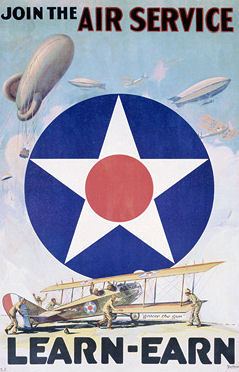 | ||
The Organization of the U.S. Army Air Service in 1925 is a snapshot of that service from its final major organizational change in June 1924, when the 1st Wing (then a training establishment) was inactivated, to its name change in July 1926 to the Air Corps. Except for activation of a school group from the Regular Army's Inactive component for primary flying training at March Field, resulting in creation of the 24th School Wing, and reallocation of four existing tactical squadrons to new groups in 1927 and 1928, the organization of the Air Corps remained largely unchanged from this list until November 1930.
Contents
- Office of the Chief of Air Service
- Training and Operations Group
- Corps Area units
- Overseas departments
- Organized Reserve and National Guard
- Organized Reserve
- National Guard
- References
The actual date of this list is February 15, 1925. At that time the Air Service had 32 tactical squadrons (eight pursuit, eight bombardment, two attack, and 14 observation), under the command of the corps areas and departments in which they were located, and 17 service and training squadrons controlled by the Office of Chief of Air Service (OCAS). The tactical squadrons were organized into seven groups and the divisional air services for three active Regular Army infantry divisions and six paper divisions. In addition to the seven tactical and two training groups active in the Regular Army, six additional groups had been constituted in the Regular Army Inactive (RAI) component to facilitate mobilization.
On that date the Air Service consisted of 922 officers and 8,749 enlisted men, out of authorized personnel ceilings of 1,516 and 8,800. In 1925 the Tenth Annual Report of the National Advisory Committee for Aeronautics, submitted by President Calvin Coolidge to the Congress on 8 December 1924, reported:
"The Air Service has 845 officers with rating as airplane pilots, airplane observers, airship pilots, airship observers, or balloon observers. In addition about 51 enlisted men have the rating of airplane pilot, junior airplane pilot, or airship pilot."
Office of the Chief of Air Service
Munitions Building, Washington, D.C.
Training and Operations Group
Corps Area units
Divisional air services were co-located with the squadron assigned. In nearly all instances, the commander of the flying unit was also the divisional air service officer. Each corps area was also assigned an air service officer, but that officer did not exercise command authority over the units allotted to that corps area.
Air Service Officer, Fort Jay, New York
9th Observation Group: Mitchel Field, New York (Major William N. Hensley, Jr.)1st Division Air ServiceAir Service Officer, Fort McHenry, Maryland
2nd Wing headquarters: Langley Field, Virginia (Major Harold Geiger)2nd Bombardment Group: Langley Field (Major John H. Pirie)Divisional Air Service, 8th DivisionAir Service Officer, Fort McPherson, Georgia
Divisional Air Service, 4th DivisionAir Service Officer, Fort Benjamin Harrison, Indiana
Divisional Air Service, 5th DivisionAir Service Officer, Fort Sheridan, Illinois
1st Pursuit Group: Selfridge Field, Michigan (Major Thomas G. Lanphier)21st Airship Group: Scott Field, Illinois (Major John A. Paegelow)Divisional Air Service, 6th DivisionAir Service Officer, Fort Crook, Nebraska
Divisional Air Service, 7th DivisionAir Service Officer, Fort Sam Houston, Texas
3rd Attack Group: Kelly Field, Texas (Major Harvey B.S. Burwell)2nd Division Air ServiceAir Service Officer, Presidio of San Francisco, California
3rd Division Air ServiceOverseas departments
Air Service Officer, Schofield Barracks, Hawaii
5th Composite Group: Luke Field, Hawaii (Major Arnold N. Krogstad)Air Service Officer, Corazal, Canal Zone
6th Composite Group: France Field, C.Z. (Major Follett Bradley)Air Service Officer, Manila
4th Composite Group: Camp Nichols, P.I. (Major Charles L. Brown)Organized Reserve and National Guard
All Organized Reserve organizations and National Guard units assigned to the Air Service were manned by personnel residing in and allotted to the Corps Area in which they were located. Organizations above the group level were nonfunctional headquarters with no active command duties in peacetime, created as mobilization organizations without training responsibilities. Groups were headquarters personnel only, with squadrons nominally assigned over which they exercised limited control during training periods. Although assigned in plans to upper echelons, they were never organized as such components. To illustrate, on February 15, 1925:
In June 1924 the Army created 31 school groups for the Organized Reserve and assigned them to the Zone of the Interior. Four were officially "organized" and remained so until September 1928, when all 31 were demobilized. Six of the other school groups were organized at some point during this period, four of which were on organized status on February 15, 1925.
By the Army's rules of unit organization, the headquarters of a National Guard division could not stand up until at least 75 percent of its subordinate units had been Federally recognized. By the end of 1924, 13 of the 18 National Guard division headquarters (under which divisional air services were organized) had been initiated, after which reduced Army budgets resulted in a two year suspension of Federal recognition of new units.
National Guard aviation had 14 observation squadrons on February 15, 1925, in contrast to the Organized Reserve, which had 73 pursuit squadrons, 21 attack squadrons, and 18 observation squadrons assigned to its groups. However in keeping with then-current legislation, National Guard units were allowed full manning (although at the time of mobilization for World War II the Guard as a whole was only at 50% strength), while O.R. units could have 100% of their authorized officer complements but no more than 33% of their enlisted strength, thus keeping most (including aviation squadrons) in a largely "on paper only" condition.
Organized Reserve
This list includes only reserve units above squadron level having an organized headquarters.
National Guard
This list includes only Federally recognized National Guard units.
